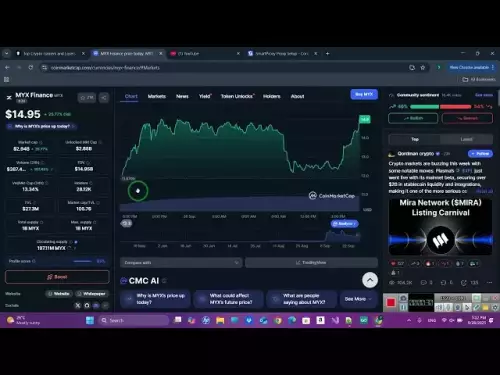-
 bitcoin
bitcoin $109547.008142 USD
0.04% -
 ethereum
ethereum $4011.838726 USD
-0.05% -
 tether
tether $1.000402 USD
-0.01% -
 xrp
xrp $2.798606 USD
0.88% -
 bnb
bnb $970.877944 USD
1.39% -
 solana
solana $202.237275 USD
-0.95% -
 usd-coin
usd-coin $0.999673 USD
0.00% -
 dogecoin
dogecoin $0.229294 USD
-1.15% -
 tron
tron $0.336370 USD
-0.45% -
 cardano
cardano $0.777260 USD
-1.66% -
 hyperliquid
hyperliquid $45.503019 USD
1.73% -
 ethena-usde
ethena-usde $1.000362 USD
0.01% -
 chainlink
chainlink $20.785303 USD
-1.10% -
 avalanche
avalanche $28.755822 USD
-0.11% -
 stellar
stellar $0.358303 USD
-0.48%
How is Bybit's index price calculated?
Bybit's index price aggregates data from top exchanges using a volume-weighted average, ensuring fair, transparent, and manipulation-resistant pricing for derivatives trading.
Sep 22, 2025 at 02:54 pm

Understanding Bybit's Index Price Mechanism
1. The index price on Bybit is designed to reflect the fair market value of a cryptocurrency by aggregating data from multiple trusted exchanges. This approach helps reduce the risk of manipulation and ensures pricing accuracy across perpetual and futures contracts.
2. Bybit pulls real-time spot prices from several top-tier exchanges such as Binance, OKX, Kraken, and Bitstamp. These exchanges are selected based on their high liquidity, trading volume, and reliability in reporting accurate data.
3. Once the prices are collected, Bybit applies a volume-weighted average method to calculate the index. This means exchanges with higher trading volumes have a greater influence on the final index value, ensuring the result closely mirrors actual market conditions.
4. The index price is updated every few seconds to maintain synchronization with fast-moving markets. This frequent refresh rate allows traders to rely on up-to-date valuations when managing positions or placing orders.
5. In cases where one exchange reports an outlier price due to technical issues or temporary disconnections, Bybit employs filtering mechanisms to exclude abnormal values. This safeguard maintains stability and prevents erroneous liquidations or funding calculations.
Role of the Index Price in Derivatives Trading
1. The primary function of the index price is to determine mark prices for open futures and perpetual contracts. Mark price influences unrealized P&L and is critical in minimizing unnecessary liquidations during volatile periods.
2. Unlike the last traded price on Bybit’s order book, the index price represents a broader market consensus. This distinction protects traders from sudden spikes or drops caused by thin order books or large single trades.
3. Funding rates in perpetual contracts are also calculated using the index price. It ensures that long and short positions are balanced fairly relative to the global spot market, discouraging excessive skew in open interest.
4. When discrepancies arise between the contract price and the index price, arbitrage opportunities emerge. Traders often act on these differences, which naturally brings the two values closer together over time.
5. Liquidation engines use the index price as a reference point to assess position health. Using this neutral benchmark reduces the likelihood of price manipulation triggering premature liquidations on low-liquidity pairs.
Data Sources and Transparency
1. Bybit discloses the list of exchanges contributing to each index, allowing users to verify data origins. For major assets like BTC/USD or ETH/USD, typically four to six exchanges are included in the calculation.
2. Each source is monitored continuously for uptime and data consistency. If an exchange fails to deliver timely updates or shows irregular behavior, it may be temporarily excluded until normal operations resume.
3. Weightings are recalibrated periodically based on 24-hour trading volume. This dynamic adjustment ensures that the most active markets have proportionally larger impact on the index.
4. Users can view the current index price alongside individual exchange contributions directly on Bybit’s trading interface. This transparency supports informed decision-making and enhances trust in platform mechanics.
5. Bybit does not include its own trade data in the index calculation, maintaining impartiality and reinforcing the integrity of price discovery.
Fair Pricing and Risk Management
1. Accurate index pricing plays a crucial role in preventing flash crashes from affecting derivative positions unfairly. Sudden dips on a single exchange do not immediately translate into mass liquidations thanks to multi-source averaging.
2. During periods of extreme volatility, such as macroeconomic announcements or security breaches, the index acts as a stabilizing force by smoothing out erratic price movements across platforms.
3. Margin requirements and maintenance levels are assessed against the index rather than the last traded price. This methodology aligns risk controls with realistic market valuations instead of transient order book imbalances.
4. Traders holding leveraged positions benefit from reduced exposure to spoofing and wash trading, as the index filters out artificial price distortions present on isolated venues.
5. Cross-margin systems utilize the index to evaluate portfolio health across multiple contracts. This holistic view enables more precise risk assessment and capital allocation strategies.
Frequently Asked Questions
What happens if one of the index sources goes offline?If a contributing exchange becomes unreachable, Bybit automatically removes it from the calculation until connectivity is restored. The remaining exchanges continue to feed data, preserving index functionality without interruption.
Can users access historical index price data?Yes, Bybit provides API endpoints and web-based tools where traders can retrieve historical index values for backtesting and analysis purposes. Data granularity includes minute-level timestamps for precision.
Is the index price used for spot trading?No, the index price is primarily utilized for derivatives pricing, including mark price, liquidation checks, and funding rate computation. Spot trades execute based on the order book’s bid and ask levels.
Why doesn’t Bybit use only one exchange for the index?Relying on a single source increases vulnerability to manipulation, downtime, and inaccurate pricing. A multi-exchange model improves resilience, accuracy, and fairness in representing true market sentiment.
Disclaimer:info@kdj.com
The information provided is not trading advice. kdj.com does not assume any responsibility for any investments made based on the information provided in this article. Cryptocurrencies are highly volatile and it is highly recommended that you invest with caution after thorough research!
If you believe that the content used on this website infringes your copyright, please contact us immediately (info@kdj.com) and we will delete it promptly.
- BTC Price Wobbles as Bitcoin ETFs See Inflows, Ethereum ETFs Bleed: What's the Deal?
- 2025-09-28 22:25:17
- Bitcoin Price Eyes Reversal? Analyst Weighs In
- 2025-09-28 22:25:17
- Shiba Inu Price Predictions: Navigating the Meme Coin Maze
- 2025-09-28 22:30:02
- GOAT Network's $GOATED: Navigating the Post-Listing Plunge
- 2025-09-28 22:30:02
- Riding the Altcoin Wave: Can Mutuum Finance Turn Pennies into Dollars Before Bitcoin's Peak?
- 2025-09-28 22:30:02
- Tapzi: Skill-to-Earn Revolution in Web3 Gaming
- 2025-09-28 22:30:13
Related knowledge

How do I use the scheduled order feature in Cardano (ADA) contracts?
Sep 28,2025 at 10:18pm
Understanding Scheduled Orders in Cardano Smart ContractsCardano operates on a proof-of-stakes consensus mechanism and uses the Plutus scripting langu...

How do I enable the "scalping-only" mode for Cardano (ADA) contracts?
Sep 24,2025 at 03:19am
Understanding Scalping Strategies in Crypto Derivatives1. Scalping in cryptocurrency trading refers to executing multiple short-term trades within min...

What is the settlement time for Cardano (ADA) contracts?
Sep 28,2025 at 04:18am
Understanding Cardano's Contract Settlement Mechanism1. Cardano operates on a proof-of-stake consensus model known as Ouroboros, which fundamentally i...

How do I add margin to Cardano (ADA) contracts?
Sep 27,2025 at 07:54pm
Understanding Margin in Cardano (ADA) Smart ContractsCardano operates on a proof-of-stake blockchain that supports smart contracts through its Plutus ...

What is the maximum position limit for Cardano (ADA) contracts?
Sep 23,2025 at 11:00pm
Understanding ADA Futures and Derivatives Market Structure1. Cardano (ADA) futures contracts are offered by several major cryptocurrency derivatives e...

What is the maker fee for Cardano (ADA) contracts?
Sep 26,2025 at 09:01am
Understanding Maker Fees in Cardano (ADA) Contracts1. The concept of maker fees applies broadly across decentralized exchanges and smart contract plat...

How do I use the scheduled order feature in Cardano (ADA) contracts?
Sep 28,2025 at 10:18pm
Understanding Scheduled Orders in Cardano Smart ContractsCardano operates on a proof-of-stakes consensus mechanism and uses the Plutus scripting langu...

How do I enable the "scalping-only" mode for Cardano (ADA) contracts?
Sep 24,2025 at 03:19am
Understanding Scalping Strategies in Crypto Derivatives1. Scalping in cryptocurrency trading refers to executing multiple short-term trades within min...

What is the settlement time for Cardano (ADA) contracts?
Sep 28,2025 at 04:18am
Understanding Cardano's Contract Settlement Mechanism1. Cardano operates on a proof-of-stake consensus model known as Ouroboros, which fundamentally i...

How do I add margin to Cardano (ADA) contracts?
Sep 27,2025 at 07:54pm
Understanding Margin in Cardano (ADA) Smart ContractsCardano operates on a proof-of-stake blockchain that supports smart contracts through its Plutus ...

What is the maximum position limit for Cardano (ADA) contracts?
Sep 23,2025 at 11:00pm
Understanding ADA Futures and Derivatives Market Structure1. Cardano (ADA) futures contracts are offered by several major cryptocurrency derivatives e...

What is the maker fee for Cardano (ADA) contracts?
Sep 26,2025 at 09:01am
Understanding Maker Fees in Cardano (ADA) Contracts1. The concept of maker fees applies broadly across decentralized exchanges and smart contract plat...
See all articles









































































